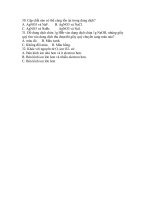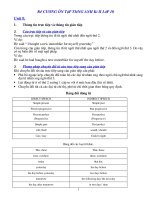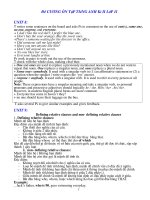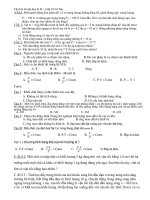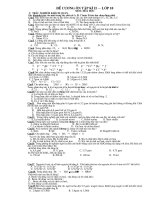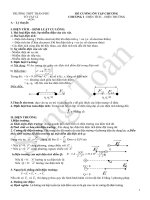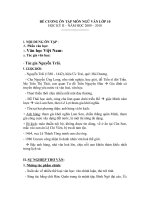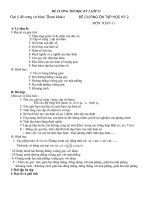DE CUONG ON TAP KI II - LOP 11 CB
Bạn đang xem bản rút gọn của tài liệu. Xem và tải ngay bản đầy đủ của tài liệu tại đây (116.46 KB, 8 trang )
Đề CƯƠNG ÔN TậP TIếNG ANH Kì II LớP 11
UNIT 8:
T writes some sentences on the board and asks Ps to comment on the use of one(s), some one,
no one, anyone, and everyone.
+ I don t like the red shirt; I prefer the blue one.
+ Don t buy the sour oranges. Buy the sweet ones.
+There s someone waiting for the director in the office.
+ Did someone call me last night?
+ Have you met anyone like him?
+ Don t tell anyone my secret.
+ No one likes her story.
+ Everyone laughs at him.
Ps work in pairs to work out the use of the pronouns.
T check with the whole class, making clear that:
+ One and ones are used to replace a previously mentioned noun when we do not want to
repeat that noun. One replaces a singular noun, and ones replaces a plural noun.
+ Some one= somebody. It used with a singular verb in (1) an affirmative statement or (2) a
question when the speaker / write expects the yes answer.
+ Anyone = anybody. It used with a singular verb. It is used to refer to every person or all
people.
Note: These expressions have a singular meaning and take a singular verb, so personal
pronouns and possessive adjectives should logically he / she. Him / her , his/ her.
However, in modern English plural forms are more common:
+ Everyone has come in havent they?
+ no one should leave their luggage on the bus.
T asks several Ps to give similar examples and gives feedback.
UNIT 9:
Defining relative clauses and non- defining relative clauses
1. Defining relative clauses:
Mệnh đề liên hệ hạn định
Đặc điểm của mệnh đề tính từ hạn định:
- Cần thiết cho nghĩa của cả câu.
- Không ở giữa 2 dấu phẩy.
- Có chức năng nh tính từ.
- Bắt đầu bằngwho, whom, which có thể đợc thay bằng that.
- Bắt đầu bằng whose có thể thay thế cho of which
Khi đề cập đến thứ gì đó thuộc về sở hữu của một quốc gia, thứ gì đó đợc tổ chức, sắp xếp thành
1 quy luật
2. non- defining relative clauses:
1
Mệnh đề liên hệ ( Không hạn định)
Mệnh đề liên hệ còn đợc gọi là mệnh đề tính từ.
Đặc điểm:
- Không tuyệt đối cần thiết cho ý nghĩa của cả câu.
- Loại bỏ mệnh đề tính từ không hạn định, mệnh đề chính vẫn có đầy đủ ý nghĩa.
- Mệnh đề tính từ không hạn định chỉ thêm một ít thông tin phụ cho mệnh đề chính.
- Mệnh đề tính từ không hạn định thờng ở giữa 2 dấu phẩy(,)
- Giữa mênh đề chính và mệnh đề không hạn định có dấu phẩy ngăn cách ở giữa.
- Bắt đầu bằng who, whom, hoặc which nhng Ko bao giờ bắt đầu bằng THAT.
Example:
_ Jacks father, who is 90, goes swimming everyday.
Who is 90 = non- defining relative clauses, chỉ cung cấp thêm chi tiết phụ mà thôi.
- The house at the end of the street, which has been empty for five years, has just been
sold.
- Which has been empty for five years= non- defining relative clauses
Mệnh đề tính từ ko hạn định ko hạn định đợc nêu ra làm ví dụ cho chúng ta biết thông tin phụ
về ngời và ngôi
nhà.
Chúng ta ko dung THAT và ko thể bỏ WHO hoặc WHICH.
Chúng ta phải đặt dấu phẩy ngay phía trớc mệnh đề tính từ ko hạn định và ngay phía sau
nó. Mệnh đề tính từ ko hạn định nằm giữa hai dấu phẩy.
- Yesterday I met Hoa, who told me, she was getting married.
Exercise: Put in the relative clauses. Supply the commas where necessary.
Example:
Zedco has ten thousand employees. It is an international company.
=> Zedco, which has ten thousand emploees, is an international company.
1. Vicky s name was missed off the list, so she wasn t very pleased.
Vicky wasn t very pleased.
2. Laura painted a picture, and it s being shown in an exhibition.
The picture...is being shown in an exhibition.
3. We re all looking forward to a concert. It s next Sartuday.
The concert.. is next Sartuday.
Answer:
1. Vicky, whose name was missed off the list, wasn t very pleased.
2. The picture which Laura painted is being shown in an exhibition.
The concert which were all looking forward, is next Saturday.
UNIT 10:
Relative Pronouns with prepositions:
Show the picture on the board. Point to the boy and tell Ps: This is Tom. This man is his
teacher.
Then ask Ps:
2
_ Who is Tom talking to? He is talking to the teacher– .
Write on the board:
The man is Tom’s teacher. Tom is talking to him.
Ask Ps: Who can combine these two sentences into one?
The man to Whom Tom is talking is his teacher.
Write some other examples on the board:
e.g: I’ll introduce you to the man. I share a flat with him.
- This is the magazine. I talked about it yesterday.
Ask Ps to combine the sentences into one.
-Copy these sentences on the board.
a- Formal:
* The man to whom Tom is talking is his teacher.
* I’ll introduce you to the man with whom I share a flat.
* This is the magazine about which I talked yesterday.
b- Informal:
* The man whom / who / that Tom is talking to is his teacher.
* I’ll introduce you to the man whom/ who / that I share a flat with.
* This is the magazine about which / that I talked yesterday.
Elicit the use of relative pronouns with prepositions from Ps.
Notes: - A relative pronoun can be the object of a preposition.
- In formal English we can put the preposition before whom or which. We cannot leave
out whom or which here, and we cannot use who or that.
- In informal English the preposition can come after the verb or the object of the verb.
We can also leave out the relative pronoun. ( Whom is formal and rather old- fashioned.
In everyday speech we often use who).
UNIT 11:
Relative clauses replaced by participles and to infinitives.
1- Active participles:
Show a picture of a girl playing with adog and tell Ps:
- She is Lan s sister. What is she doing?’
- She is playing with her dog.
Eliciting question: Who can combine the sentences into one?
Write on the board:
* The girl who is playing with the dog is Lan s sister.’
The girl playing with the dog is Lan s sister.’
* The man who spoke to John is my brother.
=> The man speaking to John is my brother.
Ask Ps to look at the examples carefully. Elicit the rules from Ps.
Write the notes on the board.
3
Note: We can use a present participle to replace a relative clause which has an active
meaning.
2- Passive participles:
Show the second picture and tell Ps:
The picture has won the first prize. It was drawn by a blind.
Ask Ps to combine the two sentences into one
The picture which was drawn by a blind has won the first prize.
The picture drawn by a blind has won the first prize.
Elicit the rule from Ps.
Write the notes on the board.
Notes:
- We can use a past participle to replace a relative clause which has a passive meaning.
3- Infinitive relative clauses:
Ask Ps:
a- Which was the first country which won the world cup?
Have Ps ask that question in another way.
Which was the first country to win the world cup?
b- The last person who leaves will have to turn out the lights.
=> The last person to leave will have to turn out the lights.
Ask Ps to look at the examples carefully.
Elicit the rules from Ps.
Write the otes on the board.
Notes:
- We can use a to- infinitive to replace a relative clause.
We offen use a to- infinitive after an ordinal number ( first, second), after next and last,
after, only, and after superlative adjectives.
UNIT 12:
Relative clauses and the omission of relative pronouns:
Ask Ps to recall the use of relative Clause.
Copy the setences below on the board.
Ask Ps to read it carefully. Elicit the use of relative pronound as subject or relative pronoun as
object.
Elicit when we can leave out the relatoive pronouns.
Relative clause( revision)
- Mệnh đề liên hệ còn đợc gọi là mệnh đề tính từ. Mỗi một mệnh đề đều có sự liên hệ với danh
từ. Tính từ hoặc cụm giới t có thể bổ nghĩa cho danh từ. Đại từ kết nối mệnh đề liên hệ với
mệnh đề chính. Các đại từ liên hệ có thể làm chủ ngữ hoặc tân ngữ cho mệnh đề.
Relative clause as Subject:
- They got on the first train that came.
- We don t like the people who/ that talk a lot.
4
* The pronouns who / which/ that can be the subject of a relative clause.
Relative clause as Object:
- They got the first train that we saw.
- I like reading the book which/ that you lent me yesterday.
* The pronouns who / which/ that can be the object of a relative clause.
Omission of relative pronouns:
We can leave out the pronoun when it is not the subject of the relative clause. Clauses without
pronouns are very common in informal English.( Chóng ta cã thÓ lîc bá c¸c ®¹i tõ quan hÖ
who, which, that khi chóng lµ t©n ng÷. Chóng ta thêng lîc bá c¸c ®¹i tõ quan hÖ nµy trong v¨n
nãi.)
- That s the lovely girl’ ( who/ that) I met at Hai s party.’
- She show me the paintings( which / that ) she had brought back from London.
Khi c¸c ®¹i tõ quan hÖ lµm chñ ng÷ cña 1 mÖnh ®Ò th× ta kh«ng thÓ lîc bá chóng ®i ®îc.
- The woman who wrote this letter is a journalist.
( NOT: The woman wrote this letter is a journalist.)
- The picture that took first prize was my uncle s.’
( NOT: The picture took first prize was my uncle s)’
UNIT 13:
T draws a boy who gave a rose to a girl.
T asks:
- What are their names?( Tom and Mary)
What did Tom do?( He gave a rose to Mary)
T: Now, who can rewrite that sentence, beginning as shown?
T writes on the BB: It was Tom.
Expected answer:
It was Tom who gave a rose to Mary.
T explains: Tom in the above sentences is subject of the sentence. To emphsize, we can begin
the sentence with It was Tom who…
Tom gave a rose to Mary.
Subject
It was Tom who gave a rose to Mary.
T draws a girl who saw a cat.
T asks: What did the girl see? ( A cat)
Yes, good. T writes:
The girl saw a cat.
T: Is the cat here the subject or object of the sentence? ( Object)
T: Who can rewrite the sentences as shown?
It was the cat…
Expected answer:
It was the cat that the girl saw.
5

